Non-QM 1099 and Profit & Loss Product Enhancements
Overview
Carrington Mortgage Services, LLC (CMS) is pleased to introduce new 1099 and P&L products for the Non-QM (Carrington Prime Advantage and Carrington Flexible Advantage Plus) programs. The underwriting guideline updates are highlighted in red below and please note these are an abbreviated summary of the guideline changes. All updates should be viewed within the context of the full guidelines available on CarringtonWholesale.com.
| Non-QM Underwriting Guidelines | |
| Old Requirements | Updated Requirements |
| 1-Year Alternative Income Documentation In lieu of the standard 2-year documentation requirement for wage-earners and self-employed borrowers, the following will be accepted:
|
1-Year Alternative Income Documentation In lieu of the standard 2-year documentation requirement for wage-earners and self-employed borrowers, the following will be accepted:
|
| Non-QM Underwriting Guidelines | |
| Old Requirements | Updated Requirements |
| 1099 Income Documentation Self-employed borrowers with earnings on IRS Form 1099, such as independent contractors and gig workers, may submit 1 or 2 years 1099 forms, subject to the following requirements:
Borrowers whose primary source of income is derived solely from the ownership of rental properties, including short-term rentals, as declared on personal or business tax returns must be calculated using Full Documentation of Income. See Rental Income. |
|
| Non-QM Underwriting Guidelines | |
| Old Requirements | Updated Requirements |
| Calculating Qualifying Income To calculate qualifying income using 1099 Income Documentation, choose one of the options below to account for business expenses: Option 1: Default Expense Factor Default Expense Factors will be applied as follows:
Multiply gross 1099 earnings by the default expense factor to determine estimated business expenses. Subtract the expense estimate from gross earnings and divide the result by 12 months for 1 year 1099 form or by 24 months for 2 years 1099 forms.
Net expenses from the Expense Statement is calculated by multiplying gross 1099 earnings by the expense percentage provided by the CPA or tax preparer. |
|
| Non-QM Underwriting Guidelines | |
| Old Requirements | Updated Requirements |
| Self-Employed 1099 Miscellaneous Income Payments to sole proprietors or contract individuals will also be reported on IRS Form 1099 form and included in the borrower’s Schedule C. If a borrower receives 1099 income, federal income tax returns for the most recent 2 years (IRS Form 1040) are required to determine the income and related expenses. When a borrower is qualified solely on W-2 wages and secondary 1099 income is discovered during the underwriting process, tax returns are not required unless the borrower requests the secondary business income to be considered. 1099 forms covering a full 2-year period are not required when a borrower changes from being paid W-2s to 1099s while working for the same employer in the same position. Documentation from the employer should be obtained to verify the borrower is not responsible for additional expenses. |
Self-Employed 1099 Miscellaneous Income Payments to sole proprietors or contract individuals will also be reported on IRS Form 1099 form and included in the borrower’s Schedule C. Borrowers who receive self-employed 1099 earnings may be qualified under the Sole Proprietorship guidelines by providing IRS Form 1040 tax returns for the most recent 1 or 2 years, or under the 1099 Income Documentation guidelines by providing IRS Form 1099 for the most recent 1 or 2 years. When a borrower is qualified solely on W-2 wages and secondary 1099 income is discovered during the underwriting process, tax returns are not required unless the borrower requests the secondary business income to be considered. 1099 forms covering a full 2-year period are not required when a borrower changes from being paid W-2s to 1099s while working for the same employer in the same position. Documentation from the employer should be obtained to verify the borrower is not responsible for additional expenses. |
| Profit & Loss Income Documentation Self-employed borrowers may submit Profit and Loss (P&L) statements covering 12 or 24 months, subject to the following requirements. Documenting Business Ownership
|
|
| Non-QM Underwriting Guidelines | |
| Old Requirements | Updated Requirements |
Requirements for P&L Documentation
Borrowers whose primary source of income is derived solely from the ownership of rental properties, including short-term rentals, as declared on personal or business tax returns must be calculated using Full Documentation of Income. See Rental Income. |
|
| Non-QM Underwriting Guidelines | |
| Old Requirements | Updated Requirements |
| Calculating Qualifying Income To calculate qualifying income using Profit and Loss Income Documentation:
|
|
Contacts
Please contact your Account Executive or Account Manager with any questions.
Carrington thanks you for your business.


